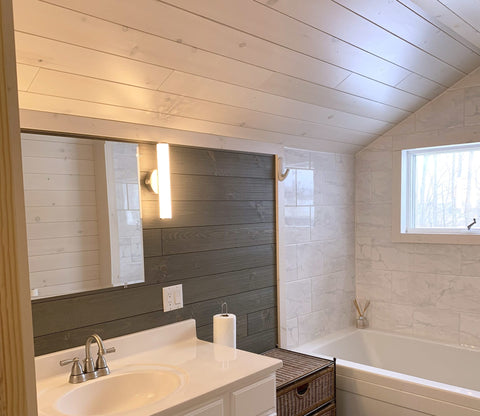Nickel Gap vs Shiplap
The modern farmhouse style is one that we love here at Homestead Timbers. One of the most common interior choices with this style is "Shiplap" but we've seen a lot of confusion around it.
Shiplap
Traditionally, shiplap did not offer even spacing between the boards, required nailing through the face, and was usually made from low grade pine. Using this shiplap to achieve a clean, consistent look would be costly and labor intensive.
The new shiplap paneling is a higher end product offering a clean look once installed. However, shiplap does not interlock like a tongue and groove product. It overlaps the previous board, hence the name ship-lap. The overlapping means that you need to face nail the board to keep them tight together. This increases the labor for the carpenter or painter to fill all of the holes if you don't want the them to be visible. Also over time, with the wood shifting from humidity it can move the face nails causing the boards to not sit flush.

The primary advantage of using shiplap in your interior design or construction projects is that it offers you the flexibility to adjust and increase the size of the gap between the individual boards to suit your specific aesthetic or functional requirements, should you desire to do so.
Today, when most people think of shiplap, this is what comes to mind.

Nickel Gap
This is actually our Nickel Gap Paneling, one of my favorite products we offer. While this isn't true shiplap, it is the look that is known and loved. Most builders prefer to use Nickel Gap instead of a true shiplap paneling for the ease of install and more consistent appearance.
Using nickel gap gets you the HGTV "shiplap" look while being easier to install.
It is cut similar to our tongue and groove paneling but instead of having a "v" where the boards meet it is cut so there is a consistent square gap between the boards.
This makes install very easy because you don't spend any time spacing the boards and the nails are put in the tongue of the board, not the face of it, giving a clean look.
Also all the boards are end matched, which makes install even easier with less waste because you don't need to start and end on the studs. Installing is as easy as leveling the base board. Locking the next board in with the tongue and groove, nailing it into place. Rinse and repeat. Since install is improved with end matching, we recommend you only account for 5% waste.
All of this makes Nickel Gap much faster and easier to install than traditional shiplap helping offset costs. Overall, this is a great product to add to your space and we offer it in 1x6 and 1x8 with 5 prefinished options as well as unfinished.
Our color selection for nickel gap is pretty diverse, some colors even compliment each other such as our whitewash and driftwood colors which pair perfectly. (See below) Check out our Nickel Gap options here.

Be sure to check out our newest product, Kebony! An alternative to tropical hardwoods for decking and siding.
Check out our other popular blogs: What to consider when remodeling your kitchen, How to paint knotty pine paneling, Buyers guide to wood flooring


